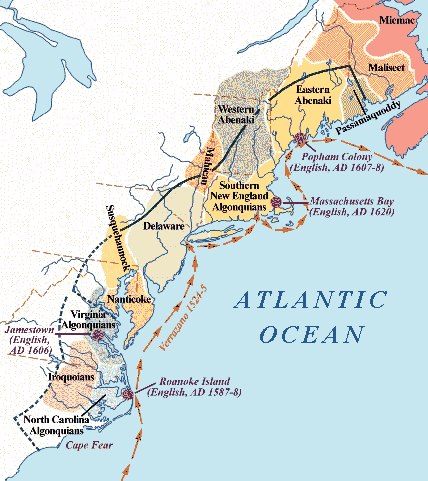|
While the Vikings colonized
Newfoundland briefly ca. AD 1000, and the Italian mariner John Cabot
reached the Great Banks fisheries in the 1490s, Giovanni Verrazzano was the
first European to sail up the mid-Atlantic coast, passing through and, at
some points, describing the region of future early English colonies.
Finding a safer route to China than the treacherous Straits of Magellan was
a high priority of 16th century European merchants, who still believed in
a “northwest passage” to the Orient. Verrazzano, a Tuscan nobleman
born in 1485, was commissioned in 1523 by a group of Italian bankers in Lyon,
at the heart of France’s silk industry, to lead an expedition seeking
such a westward passage to East Asia. With the backing of King Francis I,
Verrazano obtained four ships, a crew, and supplies enough for a year abroad.
Misfortune struck almost immediately after Verrazzano’s departure in
fall, 1523, as a violent storm annihilated two of his ships. Shortly thereafter,
a third vessel, La Normande,was sent back to France with booty from Spain.
La Dauphine, a 60-foot craft under Verrazano with 50 shipmates, was left
to cross the Atlantic alone.
Documentary evidence of Verrazzano’s letters to Francis I shows relations
between the officers and crew on this voyage were strained. While little
is known about the crew from the letters (only Girolamo, Giovanni’s
brother and the expedition cartographer, is individually mentioned), they
are referred to as la turba marittima - the maritime mob. Living conditions
in the diminutive ship no doubt accentuated social strains. The crew ate
biscuits, oatmeal, and fat; any available meat was heavily salted for
preservation during the long ocean crossing. The nutritional (Vitamin C)
void left by lack of fresh fruits and vegetables caused scurvy. Insects and
rodents competed for food supplies and fostered illnesses. Tempests at sea,
such as one raging in the western Atlantic on 24 Feb. 1524, constantly threatened
the lives of all aboard the Dauphine.
After a 44 day voyage, against all odds, on March 1, 1524 La Dauphine reached
land at Cape Fear, at the base of the Outer Banks of North Carolina (fig.1).
Verrazano initially steered the ship south to seek a protective harbor, but
before reaching as far as Charleston Harbor, he turned around to avoid meeting
hostile Spaniard ships. A small boat sent ashore at Cape Fear encountered
Indians (presumably North Carolina Algonquia ns), whom Verrazzano described
very favorably. Soon, La Dauphine sailed north along the Outer Banks, where
the leader sighted Pimlico Sound and mistook it for el mare orientale - the
Pacific Ocean. It would be nearly 100 years before cartographers stopped
depicting North America as a thin, north-south extension of land with Asia
just to the west. ns), whom Verrazzano described
very favorably. Soon, La Dauphine sailed north along the Outer Banks, where
the leader sighted Pimlico Sound and mistook it for el mare orientale - the
Pacific Ocean. It would be nearly 100 years before cartographers stopped
depicting North America as a thin, north-south extension of land with Asia
just to the west.
Fig.1: The north Atlantic coastline from Cape Fear to Newfoundland
showing Native American tribal groupings, early European settlements, and
the approximate routes of Verrazzano and other early explorers.
Continuing north, and passing by Roanoke Island (where an ill-fated English
colony was to be founded in 1587-8) Verrazzano reached what he called
“Arcadia” (probably Kitty Hawk, North Carolina), after tall trees
reminiscent of the idyllic Arcady of ancient Greece. There the crew kidnapped
a young boy, about whose fate little is known (and even less, presumably,
was idyllic). Proceeding northward, the Dauphine avoided shallows of the
coastline, which effectively prevented Girolamo from mapping the Chesapeake
and Delaware Bays. Verrazzano, however, eventually reached New York harbor
and was the first European mariner to anchor there. Here, he again met and
reported enthusiastically on the local indigenous people (a Delaware tribe,
also Algonquian-speakers). In letters back to Francis I, Verrazzano attests
to the beauty and productivity of the land, in terms of both plants and animals,
and valuable minerals which he claimed (in a promotional vein) to have spied
in the hillsides.
Sailing further east, Verrazzano and his men then encountered Block Island
and Narragansett Bay. The local Wampanoag people (New England Algonquians)
were also friendly, welcoming them with food and escorting La Dauphine to
the more sheltered Newport Harbor. Here, the ship anchored for two weeks,
where the crew traded with the Wampanoag while awaiting better weather.
Venturing still further north, the explorers reached Maine and, in a place
not far from the future Popham
Colony, encountered the
Eastern Abenaki, whom
Verrazzano describes more negatively than any tribes previously seen. While
fretting that they shot arrows at the Dauphine’s crew as they attempted
to land, could not communicate with the Europeans, and wore “carnivore
pelts,” Verrazano still has words of praise for the countryside’s
beauty. Sailing on, the explorers missed the Bay of Fundy and most of Nova
Scotia before reaching Newfoundland. They then returned to France from Fogo
Island.
Although at least partly motivated to convince King Francis I and his Lyonnaise
backers of the value of his explorations, Verrazzano’s detailed letters
provide valuable first-hand information about the eastern North American
coastline and its topography, environments, and potential resources, as well
as the first accounts of several Native American cultures.
References:
Morison, Samuel E. 1978. The Great Explorers: The European Discovery
of America. NY, Oxford Univ. Press
This article appears on p.83 in Vol.3, No.2 of Athena
Review.
.
|
|